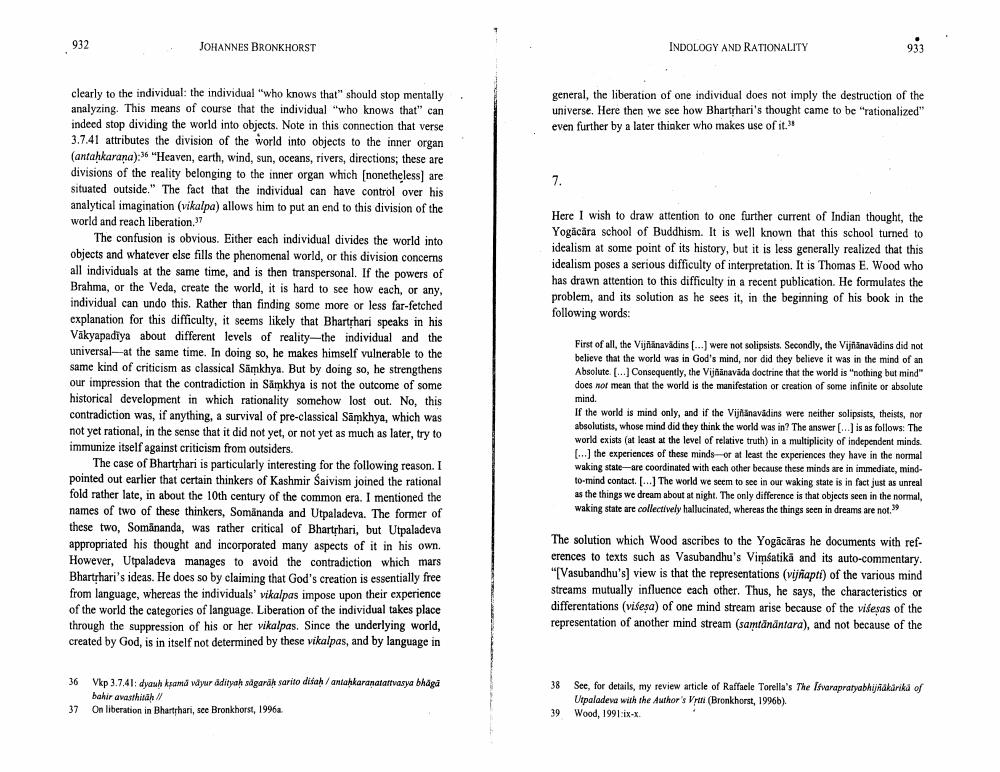Book Title: Indology And Rationality Author(s): Johannes Bronkhorst Publisher: Johannes Bronkhorst View full book textPage 9
________________ 932 JOHANNES BRONKHORST INDOLOGY AND RATIONALITY general, the liberation of one individual does not imply the destruction of the universe. Here then we see how Bharthari's thought came to be "rationalized" even further by a later thinker who makes use of it." Here I wish to draw attention to one further current of Indian thought, the Yogacara school of Buddhism. It is well known that this school tumed to idealism at some point of its history, but it is less generally realized that this idealism poses a serious difficulty of interpretation. It is Thomas E. Wood who has drawn attention to this difficulty in a recent publication. He formulates the problem, and its solution as he sees it, in the beginning of his book in the following words: clearly to the individual: the individual who knows that should stop mentally analyzing. This means of course that the individual who knows that can indeed stop dividing the world into objects. Note in this connection that verse 3.7.41 attributes the division of the world into objects to the inner organ (antahkarana): "Heaven, earth, wind, sun, oceans, rivers, directions, these are divisions of the reality belonging to the inner organ which nonetheless) are situated outside." The fact that the individual can have control over his analytical imagination (vikalpa) allows him to put an end to this division of the world and reach liberation.7 The confusion is obvious. Either each individual divides the world into objects and whatever else fills the phenomenal world, or this division concerns all individuals at the same time, and is then transpersonal. If the powers of Brahma, or the Veda, create the world, it is hard to see how each, or any, individual can undo this. Rather than finding some more or less far-fetched explanation for this difficulty, it seems likely that Bharthari speaks in his Väkyapadiya about different levels of reality-the individual and the universal at the same time. In doing so, he makes himself vulnerable to the same kind of criticism as classical Samkhya. But by doing so, he strengthens our impression that the contradiction in Samkhya is not the outcome of some historical development in which rationality somehow lost out. No, this contradiction was, if anything, a survival of pre-classical Samkhya, which was not yet rational, in the sense that it did not yet, or not yet as much as later, try to immunize itself against criticism from outsiders. The case of Bharthari is particularly interesting for the following reason. I pointed out earlier that certain thinkers of Kashmir Saivism joined the rational fold rather late, in about the 10th century of the common era. I mentioned the names of two of these thinkers, Somananda and Utpaladeva. The former of these two, Somananda, was rather critical of Bharthari, but Utpaladeva appropriated his thought and incorporated many aspects of it in his own. However, Utpaladeva manages to avoid the contradiction which mars Bharthari's ideas. He does so by claiming that God's creation is essentially free from language, whereas the individuals vikalpas impose upon their experience of the world the categories of language. Liberation of the individual takes place through the suppression of his or her vikalpas. Since the underlying world, created by God, is in itself not determined by these vikalpas, and by language in First of all, the Vijfknavidins [...) were not solipsists. Secondly, the Vijänavadins did not believe that the world was in God's mind, nor did they believe it was in the mind of an Absolute [...] Consequently, the Vijänavada doctrine that the world is "nothing but mind" does not mean that the world is the manifestation or creation of some infinite or absolute mind. If the world is mind only, and if the Vijfiänavadins were neither solipsists, theists, nor absolutists, whose mind did they think the world was in? The answer is as follows: The world exists (at least at the level of relative truth) in a multiplicity of independent minds. (...) the experiences of these minds-or at least the experiences they have in the normal waking state-are coordinated with each other because these minds are in immediate, mindto mind contact. [...] The world we seem to see in our waking state is in fact just as unreal as the things we dream about at night. The only difference is that objects seen in the normal waking state are collectively hallucinated, whereas the things seen in dreams are not." The solution which Wood ascribes to the Yogacaras he documents with references to texts such as Vasubandhu's Vimšatika and its auto-commentary. "[Vasubandhu's) view is that the representations (viffiapti) of the various mind streams mutually influence each other. Thus, he says, the characteristics or differentations (visesa) of one mind stream arise because of the višesas of the representation of another mind stream (samtänäntara), and not because of the 36 38 of Vkp 3.7,41: dvauh kaamd wyur adityah sägarah sarilo dihantahkaranatattvasya bhag bahir avasthitäh // On liberation in Bharthari, see Bronkhorst, 1996a See, for details, my review article of Raffaele Torella's The Iswarapratyabhi Aaker Utpaladeva with the Author's Vrut (Bronkhorst, 1996b) Wood, 1991:Ix-X 37 39Page Navigation
1 ... 7 8 9 10 11 12 13
